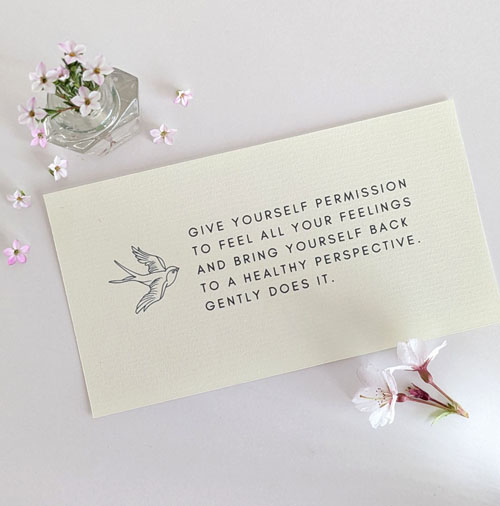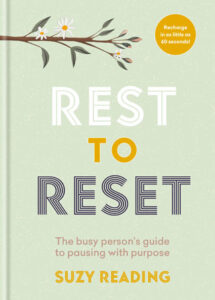What does your average day look like?
I like to begin my day with the birds, a hot cup of herbal tea and a quick encouraging post on Instagram. I leave a little love note there to set me up for the day and hope it lands for others. The kind exchanges I have there really do top me up.
Once I have the cherubs safely off to school, my daily ritual is a walk in nature’s beauty. It resources me for my day ahead, which might be writing, counselling, coaching or delivering corporate training. My day is bookended by family connection time and bed by 10pm.
What fuels your creativity?
I’m forever jotting down snippets of insights that come to me on my walks. Movement and Mother Nature always spark fresh thought. My clients are another source of inspiration – their breakthroughs help my own learnings drop in deeper and I am constantly reminded of our capacity to heal and evolve.
 Is there a person, experience, or idea that particularly inspires you and shapes what you do?
Is there a person, experience, or idea that particularly inspires you and shapes what you do?
My approach as a psychologist was very much shaped by my experience of becoming a mother at the same time as losing my father to motor neurone disease. It taught me the healing power of self-compassion, the need to learn how to nurture myself and to advocate for myself too, so that I could receive the understanding, validation, comfort and support that I needed. These are the skills I relish helping my clients develop, sustaining them through stress, loss and change.
In a culture where busyness is seen as a badge of honour, do you ever feel overwhelmed by the pressure to be productive?
My own experience of energetic bankruptcy has taught me about the need for a compassionate pace. I learned definitively that my depletion serves no one and that my replenishment serves everyone. Ultimately, without our health, what do we have?
I don’t feel guilty for resting and nourishing myself; I see these healthy habits as a necessary part of resourcing myself to deliver what’s required of me. That’s not to say that I don’t worry about deadlines or feel overwhelmed about meeting everything on my slate. I try to remind myself that I’m just one human being and it’s ok to fail at what’s humanly impossible to deliver.
Where do you start if you’re having a low-energy day but have a long to-do list?
I like to start with some quick and easy wins to get a gentle sense of momentum going and then move on to the weightier responsibilities. When I feel stuck or fatigued, I’m also a big fan of going for a short walk or five minutes of ‘legs up the wall pose’, a restorative yoga position where you sit down with your side facing the wall, roll onto your back and then stretch your legs up the wall so the whole length of your leg is supported by it. If the stretch is too intense for the hamstrings, the alternative is to lie on the floor with your legs up on the seat of a sofa, so they are held at a 90-degree bend, but still elevated. This position redistributes blood flow from the legs to the vital organs, so it is deeply replenishing without the need to fall asleep. As little as five minutes will do, but you might just need to set yourself an alarm. It helps me find clarity, and sometimes a break leads to a breakthrough.
 Have you ever dealt with imposter syndrome? If so, how have you worked through it?
Have you ever dealt with imposter syndrome? If so, how have you worked through it?
This is something I’ve experienced when releasing new books and standing up in front of big audiences for sure! I think of it as a sign that I care deeply about what I do, that I want to make sure that I’m being truthful to my remit, and that I’ve done the necessary preparation to give my best.
I look for evidence that I’m the right person to do this work and draw on my own ‘timeline of grit’ to remind me of my strengths. Ultimately, it’s just a thought, and I know that not all thoughts are true. I get to choose what I say to myself, and tender, encouraging words make all the difference.
What would you say to someone whose inner critic is giving them a hard time?
It is a habit, and it is definitely one that you can change. The starting place is to understand the difference between thoughts and self-talk. You don’t choose the first thought, it just comes to you. Because the first thought is beyond your control, there is no point trying to change it. What you do have influence over is what you say to yourself in response – your self-talk. When you notice negative, judgmental thoughts, take a step back. I’ve learnt to have a giggle at the awful things my mind generates. I deliberately choose something to counter it, something supportive.
The trick is to keep doing this until it becomes automatic. I still have unhelpful thoughts, but I’ve built a strong reflexive response of compassion and it’s truly life-changing. Don’t wait to feel worthy of it. The feeling of worth comes from being tender with ourselves.
If you could live in any decade or era, which would you choose?
I have a hankering for the bygone time of my childhood (the 70s) where our attention was less captured by devices and less consumed by the volume of communication we experience now, but I’d rather live in the present where we are breaking free from gender conditioning and toxic narratives and have much better understanding of emotional and mental health.
You’ve written books to help anxious children. What practice or tool would you recommend to calm a worried child?
To reassure a worried child, I’d recommend the practice of ‘worry time’ with a grown-up, reminding them that it is ok to feel all their feelings, that they’re not alone, and you’ll navigate it all together. This practice normalises worry – it’s something we all do, but rather than letting our worries dominate our day, we assign a particular time to sit with them and talk through them with a trusted adult. You can choose a specific time period (20 minutes should be enough), a place that feels safe and cosy, and talk through your worries together.
Part of worry time is questioning how likely these outcomes are, brainstorming ways to overcome potential fears, including times you’ve navigated something like it before and identifying sources of support if they were to eventuate. Once worry time is done, we bring our attention to other things, and when worries come up outside of designated worry time, you can remind yourself that it’s not time for it now. You’ll address it later with support.
We need a toolkit of soothing practices too, after and during worry time. ‘Hand on heart’ gesture feels calming, and a ‘candle breath’ can help us move through the energetic charge of worry – inhaling through the nose and exhaling through pursed lips as if you’re cooling a cup of hot tea.
And for a stressed-out teenager?
I’d advocate for worry time with teenagers, too and in addition, they need practices that they can turn to in the moment. As a parent of a teen, I’ve seen the volume of information they are expected to digest and remember, and the pressure to perform is huge. I try to validate the feeling – there are good reasons why they feel stressed!
As well as prioritising sleep and daily movement to help manage stress levels, simple practices like ‘chicken wing shoulder rolls’ can release physical tension and help teens breathe better and feel better. Place your fingers on your shoulders, breathe in, and lift your elbows up. As you breathe out, take them back and down. Repeat 10 times, feeling how it lifts you up into a taller, more upright posture, helping you feel more capable and ready.
What’s your go-to tip for returning to balance if you’re in fight-or-flight mode and your heart’s pounding?
I tenderly place my hand on my heart and comfort myself with some encouraging words. I remind myself that this feeling will pass, and I can be here for myself. Adding a single candle breath can help bring me back to my calm abiding centre. I love the reassurance of this hand-on-heart gesture and find myself doing it often. Every time I drink water I practice it, and it’s become a powerful anchor.
If comparison is the thief of joy, what can we do when we feel it creeping in?
I’m a huge advocate for appreciation of our blessings, but I also think sometimes we need to mourn our genuine losses too. Give yourself permission to feel all your feelings and bring yourself back to a healthy perspective by acknowledging the good in your life and how you are growing in response to life’s blows. Gently does it.
Do you have any tips for choosing comfort without self-sabotage? For example, if you’re leaning towards something that might offer relief in the moment but will make tomorrow harder.
We need some direct life-giving swaps for the comforts that sabotage our future self. Write them down to help you remember. Instead of coffee to invigorate, choose a zesty herbal tea or have a movement snack, like the chicken wing shoulder rolls (described above). Instead of scrolling, try a journaling prompt or send a text to a friend to connect, swap booze for sparkling water with magnesium powder, or some lying down yoga. Reducing temptation helps too, so if you find it hard to moderate, don’t keep it in the house, and let your loved ones know what you’re trying to achieve so they don’t unknowingly sabotage you.
You’re a strong advocate for kindness. How do you approach difficult or unkind behaviour?
I have a mantra that helps me stay anchored in compassion: ‘Hurt people, hurt people’. Rather than thinking, ‘what’s wrong with you’, it helps to ponder ‘what happened to you’. Sometimes, painful life events, or physical pain itself, can lead to ‘wounded behaviour’. It helps us feel like it’s less personal and allows us to choose ways of navigating the situation that soothe, rather than add to the inflammation. ‘Teflon shoulders’ helps me remember when something isn’t my stuff too. You can let it just slide off. It doesn’t belong to you.
Out of all the restorative practices you write about, which one do you use most in daily life?
Without doubt, hand on heart with the words, I can be tender with myself. Many, many times a day.
 > Suzy Reading is a wellness expert and author who advocates for the transformative power of self-care and rest. With self-compassion at the heart of her approach, she shares practices and tips to help restore balance, harmony and a sense of peace.
> Suzy Reading is a wellness expert and author who advocates for the transformative power of self-care and rest. With self-compassion at the heart of her approach, she shares practices and tips to help restore balance, harmony and a sense of peace.
> Book review: In Rest to Reset, Suzy Reading challenges the glorification of busyness and shares 25 practical toolkits to help bring mind and body back into balance. Published by Aster (£12.99).
Lead picture credit: Darius Bashar on Unsplash

